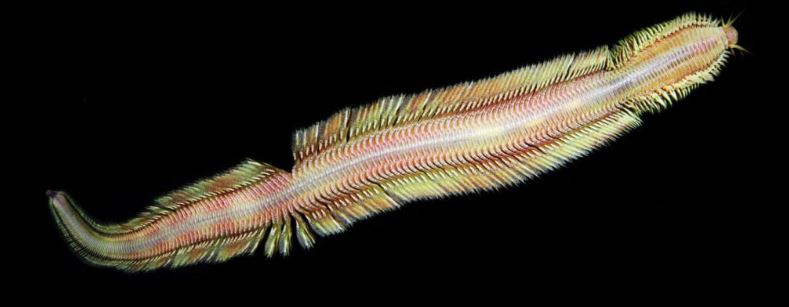


 10:9:27
10:9:27  2024-03-10
2024-03-10  1210
1210

The deep ocean is a whole world of alien mystery.
Once you start diving deep, below the range through which sunlight can penetrate, whole ecosystems unfold glimmering, glittering, and feasting in the darkness.
Case in point: In a deep environment where methane seeps from below the seafloor into the surrounding water, a shimmering new worm has been discovered.
It's been named Pectinereis strickrotti, and it marks the 48th new species discovered thriving around methane seeps off the coast of Costa Rica – an environment once thought to be too inhospitable for life to survive.
The discovery, says a team led by marine biologist Greg Rouse of the Scripps Institution of Oceanography, reveals just how little we understand Earth's oceans and the wild diversity that can be found therein.
"We've spent years trying to name and describe the biodiversity of the deep sea," Rouse says. "At this point, we have found more new species than we have time to name and describe. It just shows how much undiscovered biodiversity is out there. We need to keep exploring the deep sea and to protect it."
The ocean depths are utterly hostile to humans. Between the crushing pressure, the frigid temperatures, and the lack of light, it's very difficult for us to get there.
So there's a lot we don't know about the deeper parts of the ocean; we've explored just 5 percent of the world's oceans, and cataloged just an estimated 10 percent of the life that can be found in the depths.
But, where humans fear to tread, we develop technology to go forth. Rouse and his colleague Bruce Strickrott, lead pilot for deep-sea submersible Alvin (for whom the worm was named), first encountered the new species at a depth of about 1,000 meters (3,280 feet) in 2009 during a crewed dive off the coast of Costa Rica.
"We saw two worms near each other about a sub's length away swimming just off the bottom," Strickrott recalls. "We couldn't see them well and tried to creep in for a closer look, but it's hard to creep in a submarine and we spooked them."
And that was that, until 2018, when the team was able to return to the same spot. To their surprise, they encountered the same creature – not one individual, but six, undulating confidently in the water. This time, the submersible was able to approach.
The team collected images, videos, and even specimens. With this bounty acquired, they retreated to an atmosphere environment to catalog and study their finds.
The collection revealed that what they had was a new species of marine worm belonging to the Nereididae family, also known as ragworms. Like other members of the family, P. strickrotti is a segmented polychaete worm with a long body whose sides are bristling with leg-like appendages called parapodia, and hidden jaws that emerge for feeding.
In several very interesting ways, P. strickrotti is unlike other known ragworms. For a start, most known ragworms inhabit much shallower waters. Because it lives in the bathypelagic darkness, P. strickotti is blind. In addition, most known ragworms absorb oxygen through their parapodia without the aid of gills, whereas P. strickrotti's parapodia are covered with gills.
In general, Nereididae have two life stages: the immature atoke stage in which they spend most of their lives in a burrow on the seafloor; and the adult epitoke stage which emerges and swim freely to breed before dying.
As most of the specimens collected here were free-swimming males, and the only (partial) female sample was collected from the sediment, the team suspects in this species it might be only the males that become epitokes.
Moreover, the males had unusual non-reproductive epitokous characteristics that appear to be unique among Nereididae. It will take further investigation to reveal the way the worm lives, and why it needs these characteristics.
It's also not known what the creature eats, although studying the chemosynthetic food web that emerges around methane seeps could help figure that out.
More importantly, though, the peculiar worm gives us a glimpse into the vast abyss of our own unknowing, and the strange wonders of this world just waiting for us to find them.
Reality Of Islam |
|

"It is

The process

Astronomers

Cosmologist
 9:3:43
9:3:43
 2018-11-05
2018-11-05
10 benefits of Marriage in Islam
 7:5:22
7:5:22
 2019-04-08
2019-04-08
benefits of reciting surat yunus, hud &
 9:45:7
9:45:7
 2018-12-24
2018-12-24
advantages & disadvantages of divorce
 11:35:12
11:35:12
 2018-06-10
2018-06-10
 6:0:51
6:0:51
 2018-10-16
2018-10-16
 10:35:40
10:35:40
 2022-05-26
2022-05-26
 3:18:29
3:18:29
 2022-12-24
2022-12-24
 4:26:43
4:26:43
 2022-02-21
2022-02-21
 7:59:14
7:59:14
 2018-06-21
2018-06-21
 12:10:56
12:10:56
 2022-11-17
2022-11-17
 7:32:24
7:32:24
 2022-02-14
2022-02-14
 2:13:43
2:13:43
 2022-05-27
2022-05-27
 5:41:46
5:41:46
 2023-03-18
2023-03-18
| LATEST |